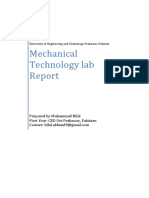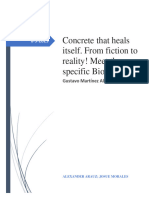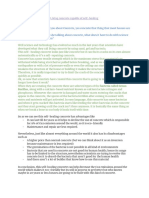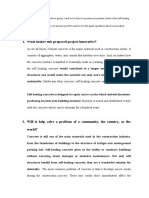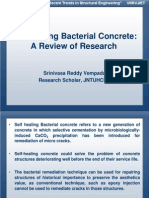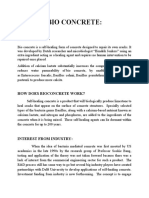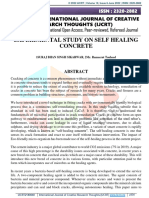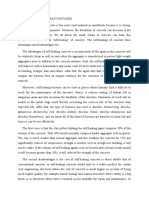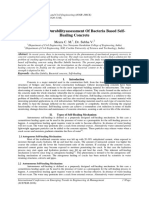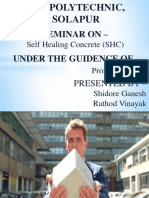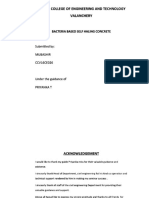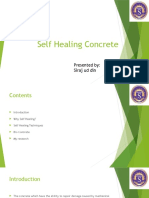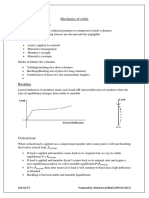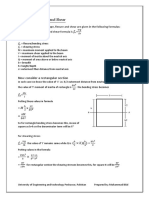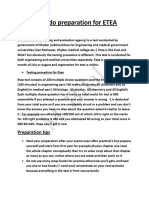100%(1)100% found this document useful (1 vote)
369 viewsSelf Healing Concrete PDF
Self Healing Concrete PDF
Uploaded by
Bilal Akhundzadaa short intro of self healing concrete that how it works , what are the advantages and disadvantages and how it will change the world.
Copyright:
© All Rights Reserved
Available Formats
Download as PDF, TXT or read online from Scribd
Self Healing Concrete PDF
Self Healing Concrete PDF
Uploaded by
Bilal Akhundzada100%(1)100% found this document useful (1 vote)
369 views10 pagesa short intro of self healing concrete that how it works , what are the advantages and disadvantages and how it will change the world.
Original Title
Self Healing Concrete.pdf
Copyright
© © All Rights Reserved
Available Formats
PDF, TXT or read online from Scribd
Share this document
Did you find this document useful?
Is this content inappropriate?
a short intro of self healing concrete that how it works , what are the advantages and disadvantages and how it will change the world.
Copyright:
© All Rights Reserved
Available Formats
Download as PDF, TXT or read online from Scribd
Download as pdf or txt
100%(1)100% found this document useful (1 vote)
369 views10 pagesSelf Healing Concrete PDF
Self Healing Concrete PDF
Uploaded by
Bilal Akhundzadaa short intro of self healing concrete that how it works , what are the advantages and disadvantages and how it will change the world.
Copyright:
© All Rights Reserved
Available Formats
Download as PDF, TXT or read online from Scribd
Download as pdf or txt
You are on page 1of 10
Self Healing Concrete
Prepared by Muhammad Bilal
CED,UET Peshawar
What is self healing concrete?
Self-healing concrete could solve the problem of concrete
Structures that Weaken well before the end of their service life.
Traditional Concrete has a flaw
when Subjected to tension.
The concrete is mixed with a
Bacteria bacillus Pseudofirmus
After it cracks the water gets into
the concrete, activating the bacteria
Inside. This bacteria then start
Producing limestone to fill in the
Cracks naturally.
How does bio
concrete work?
Self-healing concrete is a product
that will biologically produce
limestone to heal cracks that
appear on the surface of concrete
structures. Specially selected types
of the bacteria genus Bacillus,
along with a calcium-based
nutrient known as calcium lactate,
and nitrogen and phosphorus, are
added to the ingredients of the
concrete when it is being mixed.
These self-healing agents can lie
Inert within the concrete for up to
200 years.
Why the Need?
Concrete will continue to be the most important
building material for infrastructure but most concrete
structures can suffer from cracking. Tiny cracks on the
surface of the concrete make the whole structure
unsafe because water seeps in to degrade the concrete
and corrode the steel reinforcement, greatly reducing
the lifespan of a structure.
Repairs can be particularly time consuming and
expensive because it is often very difficult to gain
access to the structure to make repairs, especially if
they are underground or at a great height.
Some disadvantages
There are two key obstacles that need to be overcome
if self healing concrete is to transform concrete
construction in the next decade.
The First disadvantage is the cost of self-healing
concrete is about double that of conventional
concrete, which is presently about 80 euros per
cubic meter. If the life of the structure can be
extended by 30%, the doubling in the cost of the
actual concrete would still save a lot of money in the
longer term.
Second Self healing concrete has low
compressive strength. In many structures this
would not be a problem but in specialized
applications where higher compressive strength
is needed, such as in high-rise buildings, it will
not be viable.
Finding the right bacteria
The starting point of the research was to find bacteria
capable of surviving in an extreme alkaline
environment. Cement and water have a pH value of up
to 13 when mixed together.
Samples of endolithic bacteria (bacteria that can live
inside stones) were collected along with bacteria found
in sediments in the lakes. Strains of the bacteria genus
Bacillus were found to thrive in this high-alkaline
environment. A suitable food source for bacteria so
they can survive for long time in concrete as calcium
lactate.
Interest from industry
The researchers are also developing a liquid to fix
cracks in conventional concrete. The bio concrete can
save billions and will be a major break through in the
field of civil engineering.
It is not practically used yet but there will be full scale
testing of self healing concrete to determine how well
and fast they heal over time.
Research is under process on bio concrete mark II to
reduce the cost of the concrete.
You might also like
- Self Healing Concrete PPT MuDocument22 pagesSelf Healing Concrete PPT MuMubashir Pullippat50% (2)
- Self Healing Concrete - PpsDocument17 pagesSelf Healing Concrete - PpsShubham Agarwal0% (1)
- Report :SELF HEALING CONCRETEDocument19 pagesReport :SELF HEALING CONCRETEPrabhat Kumar Sahu94% (18)
- Mechanical Technology Lab ReportDocument16 pagesMechanical Technology Lab ReportBilal Akhundzada100% (2)
- Leon County Sheriff'S Office Daily Booking Report 18-Oct-2021 Page 1 of 3Document3 pagesLeon County Sheriff'S Office Daily Booking Report 18-Oct-2021 Page 1 of 3WCTV Digital TeamNo ratings yet
- ExercitiiDocument8 pagesExercitiiAdrian IștvanNo ratings yet
- Inspection Checklist For Hvac (DUCT Installation) F01 & F02Document4 pagesInspection Checklist For Hvac (DUCT Installation) F01 & F02Researcher100% (2)
- CellphonesDocument3 pagesCellphonesesmeralda0385100% (1)
- The end of concrete: Pros and cons of an unsuccesful technologyFrom EverandThe end of concrete: Pros and cons of an unsuccesful technologyRating: 1 out of 5 stars1/5 (1)
- Self Healing Concrete Synopsis PrintDocument7 pagesSelf Healing Concrete Synopsis PrintASHEESH KUMAR SRIVASTAVANo ratings yet
- PPTDocument3 pagesPPTvinodh159No ratings yet
- Bio ConcreteDocument4 pagesBio Concretefimodeg778No ratings yet
- Self Healing Concrete - A Sustainable Future: B. E. Civil Engineering G.H.R.C.E.M.,, PUNEDocument7 pagesSelf Healing Concrete - A Sustainable Future: B. E. Civil Engineering G.H.R.C.E.M.,, PUNETejaswiniNo ratings yet
- Naresh Technical Seminar ReportDocument18 pagesNaresh Technical Seminar Reportbikesh20007No ratings yet
- Self Healing ConcreteDocument8 pagesSelf Healing ConcreteRitesh kumar Sharma0% (1)
- Self Healing ConcreteDocument7 pagesSelf Healing Concreteashish9katariya100% (1)
- Article English 1Document5 pagesArticle English 1Alexander ArauzNo ratings yet
- Article English 1 Alexander ArauzDocument5 pagesArticle English 1 Alexander ArauzAlexander ArauzNo ratings yet
- Documento Sin TítuloDocument1 pageDocumento Sin TítuloAriday CorlettoNo ratings yet
- BioconcreteDocument12 pagesBioconcreteMoeesha KenkreNo ratings yet
- Self Healing Concretre SITDocument36 pagesSelf Healing Concretre SITgaurav jhaNo ratings yet
- Self Healing ConcreteDocument22 pagesSelf Healing ConcreteMarc Alamo100% (2)
- Answers To QuestionsDocument8 pagesAnswers To QuestionsAbigail VNo ratings yet
- Self Healing ConcreteDocument21 pagesSelf Healing ConcretethirumalNo ratings yet
- Siliguri Institute of TechnologyDocument13 pagesSiliguri Institute of Technologykmbd SiliguriNo ratings yet
- Self Healing ConcreteDocument3 pagesSelf Healing Concreteश्रेया पराजुलीNo ratings yet
- VNRVJIETDocument19 pagesVNRVJIETvempadareddyNo ratings yet
- What Is Bacterial ConcreteDocument1 pageWhat Is Bacterial Concretejahremade jahremadeNo ratings yet
- Amit RRDocument21 pagesAmit RRsfhjxdgh83No ratings yet
- Bacteria 4Document1 pageBacteria 4jahremade jahremadeNo ratings yet
- National Institute of Technology Raipur: Bio-ConcreteDocument19 pagesNational Institute of Technology Raipur: Bio-ConcreteRahul DhakerNo ratings yet
- Bio ConcreteDocument3 pagesBio ConcreteJason royNo ratings yet
- Self Healing ConcreteDocument13 pagesSelf Healing ConcreteAbigail VNo ratings yet
- Importance of Self Healing ConcreteDocument19 pagesImportance of Self Healing ConcreteAnonymous gA8TMWG1pw86% (7)
- Bacterial Concrete or Self Healing Concrete For Crack RepairsDocument6 pagesBacterial Concrete or Self Healing Concrete For Crack RepairsAnish PandeyNo ratings yet
- Self Healing ConcreteDocument5 pagesSelf Healing ConcreteKeshab BhattaraiNo ratings yet
- Bio ConcreteDocument3 pagesBio ConcreteKabeer AliNo ratings yet
- Bacterial Concrete: A Review: Pappupreethi K, Rajishavelluva AmmakunnothDocument7 pagesBacterial Concrete: A Review: Pappupreethi K, Rajishavelluva AmmakunnothIAEME PublicationNo ratings yet
- Bacterial ConcreteDocument14 pagesBacterial Concretepitta2022bciv157No ratings yet
- Self Healing ConcreteDocument12 pagesSelf Healing ConcreteVivek Makhecha100% (2)
- IJCRT21X0040Document57 pagesIJCRT21X0040Shaik yahiya rizwanNo ratings yet
- "Bioconcrete": CHM031: Chemistry For EngineersDocument4 pages"Bioconcrete": CHM031: Chemistry For EngineersIrish AthensNo ratings yet
- Ijirt158904 PaperDocument5 pagesIjirt158904 PaperGodwin KopelliNo ratings yet
- Untitled PresentationDocument8 pagesUntitled PresentationDevNo ratings yet
- Advantages and Disadvantages of SelfhealingDocument3 pagesAdvantages and Disadvantages of SelfhealingSiti HajarNo ratings yet
- Self-Healing ConcreteDocument37 pagesSelf-Healing ConcreteAhtesham Khan100% (1)
- MurakmarDocument4 pagesMurakmarAndres CuadrosNo ratings yet
- Self Healing1Document7 pagesSelf Healing1Gaurav ChauhanNo ratings yet
- Self Healing Concrete SeminarDocument32 pagesSelf Healing Concrete SeminarAru GowdaNo ratings yet
- Bio Concrete AbstractDocument1 pageBio Concrete AbstractVishnoo SadhasivamNo ratings yet
- Ijciet 08 02 061Document8 pagesIjciet 08 02 061Ki KiethNo ratings yet
- IjsrdDocument5 pagesIjsrdKaran PatilNo ratings yet
- Articulo Bio ConcretoDocument4 pagesArticulo Bio ConcretoHamilton LopezNo ratings yet
- SEMINARDocument12 pagesSEMINARVishala SharmaNo ratings yet
- Bioconcrete: Submitted in Partial Fulfillment of The Requirements For Chemistry For Engineers (CHM031)Document4 pagesBioconcrete: Submitted in Partial Fulfillment of The Requirements For Chemistry For Engineers (CHM031)JP EstacioNo ratings yet
- Routes and Mechanisms Towards Self Healing Behavior in Engineering MaterialsDocument5 pagesRoutes and Mechanisms Towards Self Healing Behavior in Engineering MaterialsvempadareddyNo ratings yet
- Selfhealingconcretepptforseminar2 150829181258 Lva1 App6891 PDFDocument21 pagesSelfhealingconcretepptforseminar2 150829181258 Lva1 App6891 PDFRishav Singh MehraNo ratings yet
- Bacterial ConcreteDocument21 pagesBacterial Concretesubeersubi720No ratings yet
- Presentation Bacterial ConcreteDocument26 pagesPresentation Bacterial ConcreteHazbullah ShajiNo ratings yet
- Self Healing BookDocument16 pagesSelf Healing BookSHANMUGAVEL KUMARNo ratings yet
- Self Healing ConcreteDocument15 pagesSelf Healing ConcreteJohnNo ratings yet
- Self Healing ConcreteDocument17 pagesSelf Healing ConcreteSirajUdDinNo ratings yet
- What's Bugging Your Pipes: How Microorganisms Affect Plumbing SystemsFrom EverandWhat's Bugging Your Pipes: How Microorganisms Affect Plumbing SystemsRating: 4 out of 5 stars4/5 (1)
- Compression MembersDocument2 pagesCompression MembersBilal AkhundzadaNo ratings yet
- Soil Mechanics II (Geotech Engg) Lab ReportDocument44 pagesSoil Mechanics II (Geotech Engg) Lab ReportBilal Akhundzada100% (1)
- Fluid Mechanics Lab ReportDocument35 pagesFluid Mechanics Lab ReportBilal Akhundzada0% (1)
- Analysis of Internal ForcesDocument2 pagesAnalysis of Internal ForcesBilal Akhundzada100% (3)
- Design For Flexure and Shear (Rectangular & Square Section)Document1 pageDesign For Flexure and Shear (Rectangular & Square Section)Bilal AkhundzadaNo ratings yet
- Shear Force and Bending Moment DiagramDocument12 pagesShear Force and Bending Moment DiagramBilal AkhundzadaNo ratings yet
- Report On Safety Measures During ConstructionDocument26 pagesReport On Safety Measures During ConstructionBilal AkhundzadaNo ratings yet
- Presented by Muhammad BilalDocument7 pagesPresented by Muhammad BilalBilal AkhundzadaNo ratings yet
- Steam Cycles: Figure 8.1 (Carnot Cycle For Wet Vapor Under T-S Diagram)Document5 pagesSteam Cycles: Figure 8.1 (Carnot Cycle For Wet Vapor Under T-S Diagram)Bilal AkhundzadaNo ratings yet
- Nust Merit List 2016Document2 pagesNust Merit List 2016Bilal AkhundzadaNo ratings yet
- How To Do Preparation For EteaDocument2 pagesHow To Do Preparation For EteaBilal AkhundzadaNo ratings yet
- ISO Standard of Drawing SheetsDocument3 pagesISO Standard of Drawing SheetsBilal AkhundzadaNo ratings yet
- Asphalt: Presented by Muhammad Bilal Class No:151Document9 pagesAsphalt: Presented by Muhammad Bilal Class No:151Bilal AkhundzadaNo ratings yet
- SolarDocument33 pagesSolarmitrangaNo ratings yet
- Edwin LockeDocument4 pagesEdwin Locke6ynkzmmcfvNo ratings yet
- Documentation-Datanit - KN ProbeDocument2 pagesDocumentation-Datanit - KN ProbeAmit DeoreNo ratings yet
- Flour Testing Device With Automatic Water Dosing System Y38 - EngDocument4 pagesFlour Testing Device With Automatic Water Dosing System Y38 - EngRadouan SahbNo ratings yet
- Hydraulic Cylinder TroubleshootingDocument8 pagesHydraulic Cylinder Troubleshootingcristi_ama100% (1)
- MODULE-Basic SafetyDocument55 pagesMODULE-Basic SafetyalharbamirNo ratings yet
- Diccionario EspaÑol InglÉsDocument726 pagesDiccionario EspaÑol InglÉservin-i-van9732100% (9)
- Osmosis LabDocument3 pagesOsmosis LabShaneece BogleNo ratings yet
- Features: 40A Drmos Power Module With Integrated Diode Emulation and Thermal Warning OutputDocument15 pagesFeatures: 40A Drmos Power Module With Integrated Diode Emulation and Thermal Warning OutputantoniocljNo ratings yet
- Case Femur RevDocument30 pagesCase Femur RevWilliamtatokieesz Tembokrumahampebenjol-benjolNo ratings yet
- Reviewer in PEDocument4 pagesReviewer in PERosheen NuguitNo ratings yet
- EOR MethodsDocument16 pagesEOR MethodsPankaj KumarNo ratings yet
- GR 12 A6 - 7 Add NotesDocument3 pagesGR 12 A6 - 7 Add NotesShaimaa SalamaNo ratings yet
- On Semiconductor 2N7000 D26Z DatasheetDocument8 pagesOn Semiconductor 2N7000 D26Z DatasheetVũ Huy Nhật MinhNo ratings yet
- Main Organic Acid Distribution of Authentic Citrus Juices in Turkey (#138557) - 119982Document5 pagesMain Organic Acid Distribution of Authentic Citrus Juices in Turkey (#138557) - 119982Ben WunderNo ratings yet
- Milk DietDocument182 pagesMilk DietBetim PantinaNo ratings yet
- FREEKOTEDocument6 pagesFREEKOTEKartikeya SharmaNo ratings yet
- DMSCO Log Book Vol.2 7/1924-6/1925Document89 pagesDMSCO Log Book Vol.2 7/1924-6/1925Des Moines University Archives and Rare Book RoomNo ratings yet
- A History of Remarkable Acclaim: Appellation Vista Flores Appellation La ConsultaDocument2 pagesA History of Remarkable Acclaim: Appellation Vista Flores Appellation La ConsultamorenacaixasNo ratings yet
- Community Aquired Pneumonia (: Diagnosis CAP) and Current Management Yunita ArliniDocument12 pagesCommunity Aquired Pneumonia (: Diagnosis CAP) and Current Management Yunita ArliniSundas EjazNo ratings yet
- Allianz Product Disclosure Sheet - Professional Indemnity (English)Document3 pagesAllianz Product Disclosure Sheet - Professional Indemnity (English)Eddie TweNo ratings yet
- Sports Nutrition Recipe BookDocument20 pagesSports Nutrition Recipe BookPetar GranićNo ratings yet
- Moringa BenefitsDocument10 pagesMoringa BenefitsApanama StudioNo ratings yet
- Solid State-01 (Theory)Document52 pagesSolid State-01 (Theory)Raju SinghNo ratings yet
- Support Worker - Job Description 2021Document3 pagesSupport Worker - Job Description 2021Collins MghaseNo ratings yet
- Basics of Biomedical Ultrasound For Engineers - 2010 - Azhari - FrontmatterDocument13 pagesBasics of Biomedical Ultrasound For Engineers - 2010 - Azhari - Frontmattershifaul fitriNo ratings yet




